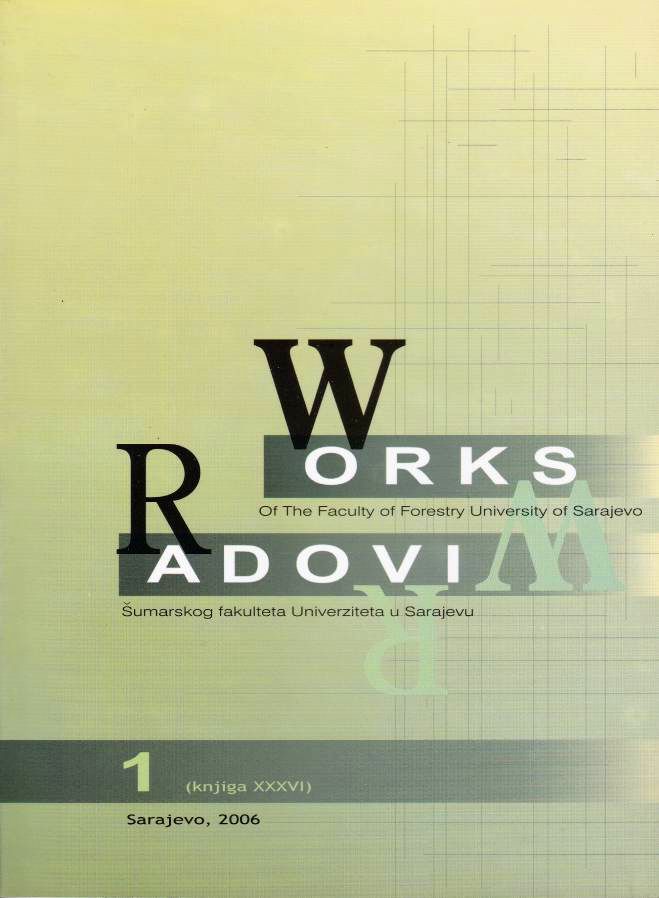The analysis of flourishing of six conifer species in the area of Gostovićka rijeka
DOI:
https://doi.org/10.54652/rsf.2006.v36.i1.189Keywords:
conifers, number of trees, chest diameter, height, volume, production characteristicsAbstract
UDK 630*5:582.4(497.6)
With the aim to research the production potential of 6 conifer species (3 autochthonous and 3 allochtonous): Douglas fir (Pseudotsuga mensiesii Franco.), Norway spruce (Picea abies Karst.), European larch (Larix eurpea L.), Japanese larch (Larix leptolepis Gord.), Scots pine (Pinus sylvestris L.) and Austrian pine (Pinus nigra Arn.) at the locality of Begova vratnica, Central Bosnia, in the year 1960, the comparative trial was based in a block system with three repetitions. At the age of 46 we measured the diameters and the height of the trees, and verified and analyzed the number of trees per hectare, the medium diameter at base, medium height, basal area, the volume and the average volume growth.
The greatest percentage of survival was verified for the Norway spruce (30, 42%) and Austrian pine (24, 37%), somewhat lower for the Douglas fir (18, 95%), the Scots pine (14, 82%) and the European larch (11, 17%), and exceptionally law for the Japanese larch (7, 95%).
The Douglas fir has reached the highest medium height (24, 15 m), followed by the Japanese larch (23, 65 m), the Scots pine (21, 23 m), the European larch (21, 21 m), the Austrian pine (21, 12 m) and the Norway spruce (20, 08 m). Similar sequence of the tree species was verified with regard to the medium diameter sizes, with the only difference reported between the Norway spruce and the Austrian pine. By analysis of the variance and by t-index test, with the level of significance of 5%, it was determined that there exist statistically significant differences in medium heights and diameters between the respective tree species.
The productivity of the respective tree species was analyzed by comparison of the volume of the large trees and the number of trees (per ha) of the subject plantations with the corresponding table data. The best results were obtained for the Norway spruce and the Douglas fir. The volume of the Norway spruce (646,333 m3/ha), with lesser number of trees was 7%, and was higher for 77% from the table’s volumes, while the volume of the Douglas fir (606,940 m3/ha), with greater number of trees was 9%, and was higher for 61% from the table based volume. Other tree species, as well, with lesser number of trees produced greater volumes with minor differences among respective species.
References
BALLIAN, D., MIKIĆ, T., PINTARIĆ, K. (1999): Analiza uspijevanja 5 provenijencija zelene duglazije (Pseudotsuga menziesii Mirb. Franco.) u pokusu Batalovo brdo. Šumarski list, br. 9-10, CXXIII, str. 423-430. Zagreb.
BALLIAN, D., MIKIĆ, T., PINTARIĆ, K., ŠČEKIĆ, M. (2003): Analiza rasta zelene duglazije (Pseudotsuga menziesii Mirb. Franco.) u IUFRO pokusu «Gostović» Zavidovići. Radovi.
BALIĆ, B. (2003): Model rasta i prirasta jednodobnih nenjegovanih šumskih zasada bijelog bora (Pinus sylvestris L.) na karbonatnim supstratima u Bosni. Magistarski rad. Šumarski fakultet. Sarajevo.
BEZAK, K. (1992): Tablice drvnih masa cera, crnog bora i običnog bora. Radovi Šumarskog instituta Jastrebarsko. Zagreb.
EKINOVIĆ, S. (1997): Metode statističke analize u Microsoft Exscel-u. Mašinski fakultet. Zenica.
IBRAHIMSPAHIĆ, A. (2004): Regresione analize proizvodnih karakteristika jednodobnih nenjegovanih šumskih zasada crnog bora (Pinus nigra Arn.) na karbonatnim supstratima u Bosni. Magistarski rad. Šumarski fakultet. Sarajevo.
KOPRIVICA, M. (1997): Šumarska biometrika. Institut za šumarstvo Beograd. Knjiga I. Beograd.
MAUNAGA, Z. (1989): Proizvodne i strukturne karakteristike jednodobnih sastojina crnog bora (Pinus nigra Arn.) U Hercegovini. Magistarski rad. Šumarski fakultet Univerziteta u Sarajevu.
ORLIĆ, S. ET AL. (1995): Uspijevanje šest vrsta četinjača u području bujadica i vriština. Šumarski list, br. 5-6, CXIX, str. 169-178. Zagreb.
ORLIĆ, S. ET AL. (1997): Uspijevanje šest vrsta četinjača na lesiviranom tlu na području Bjelovara. Šumarski list, br. 7-8, CXXI, str. 361-370. Zagreb.
PINTARIĆ, K. (2002): Šumsko-uzgojna svojstva i život važnijih vrsta šumskog drveća. Udruženje šumarskih inženjera i tehničara Federacije Bosne i Hercegovine.
SCHOBER, R. (1975): Ertragstafeln wichtiger Baumarten. J.D. Sauerländer’s Verlag. Frankfurt am Main.
(1986) Dugoročni program razvoja šumarstva u BiH za period od 1986. do 2000.godine. Republički Komitet za poljoprivredu, šumarstvo i vodoprivredu. Sarajevo.


















